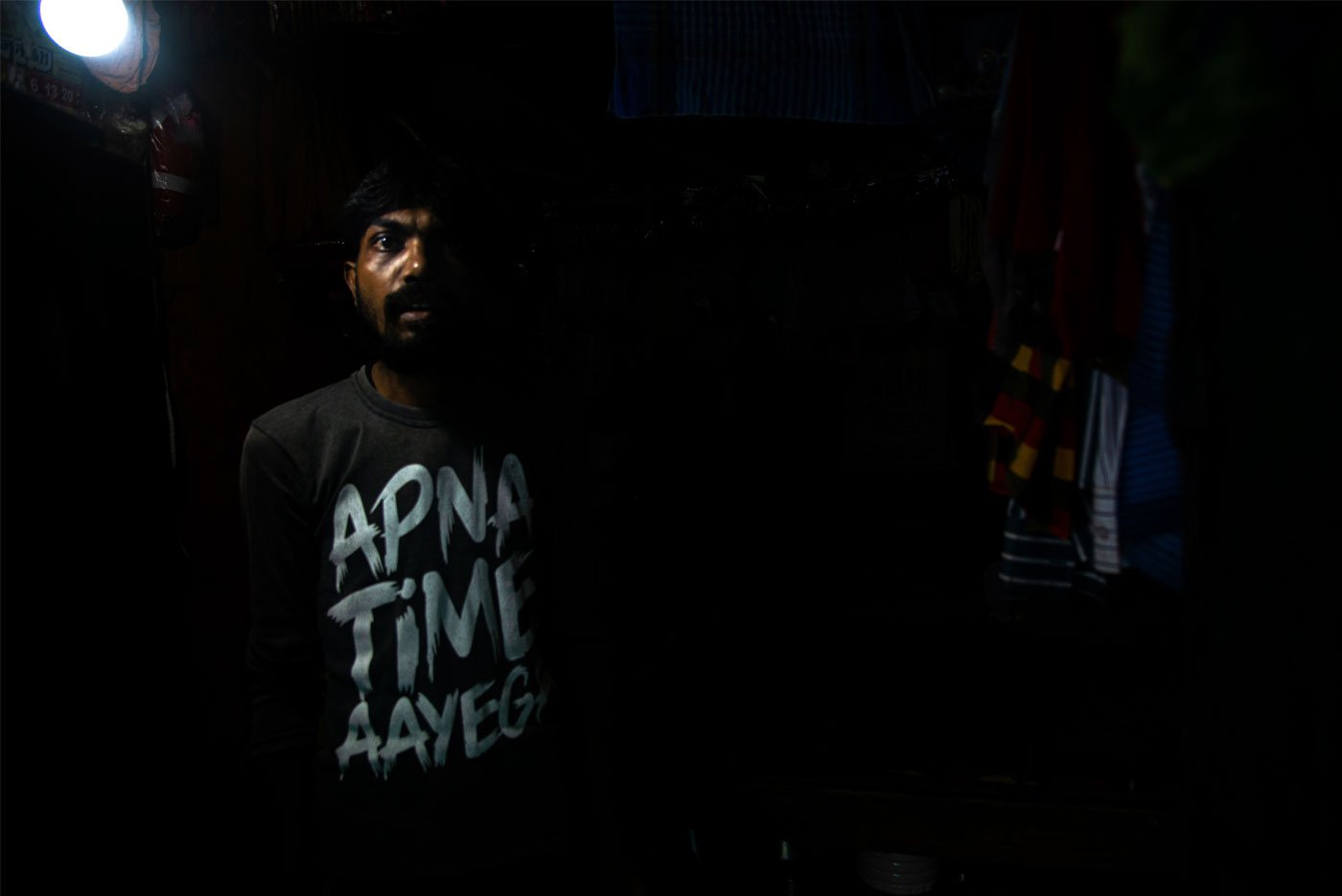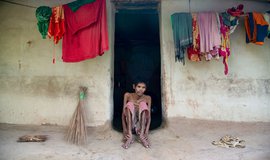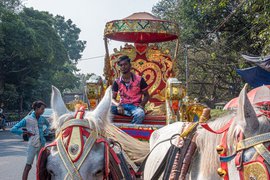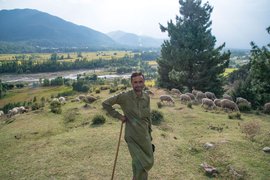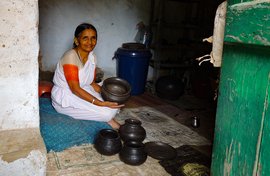Zamil is skilled in embroidery that uses fine zari (gold) thread. The 27-year-old worker in Howrah district adds glitter and shine to expensive garments, sitting for hours on the floor with his legs folded. But, soon after he contracted bone tuberculosis (TB) in his twenties, he had to put this needle and thread away. The disease had made his bones so weak that folding them for long hours was no longer an option for him.
“This is my age for working, and [my] parents should rest. But the exact opposite is happening. They have to work to support my medical treatment,” says the young man who lives in Chengail locality of Howrah district and travels to Kolkata for treatment.
In the same district, Avik and his family live in the Pilkhana slum in Howrah, and the teenager also has bone TB. He had to drop out of school in mid-2022 and although he is recovering, he is still unable to go to school.
I first met Zamil, Avik and others when I began covering this story in 2022. I would often visit them in their homes in the slums of Pilkhana to get to know them as I photographed them going about their daily life.
Unable to afford private clinics, Zamil and Avik initially came for check-ups to a mobile TB clinic run by a non-governmental organisation working to support patients in rural areas of South 24 Parganas and Howrah district. They are not alone.


Left: When Zamil developed bone tuberculosis, he had to give up his job as a zari embroiderer as he could no longer sit for hours. Right: Avik's lost the ability to walk when he got bone TB, but now is better with treatment. In the photo his father is helping him wear a walking brace


An X-ray (left) is the main diagnostic tool for detecting pulmonary tuberculosis. Based on the X-ray reading, a doctor may recommend a sputum test. An MRI scan (right) of a 24-year-old patient shows tuberculosis of the spine (Pott’s disease) presenting as compression fractures
“Tuberculosis has re-emerged as a major public health problem,” says the recent National Family Health Survey 2019-21( NFHS-5 ). India accounts for 27 per cent of all TB cases worldwide (World Health Organisation’s TB Report , published in November 2023).
The mobile team of two doctors and 15 nurses would travel roughly 150 kilometres in a day, visiting four or five different locations to offer healthcare services to those who can’t afford to travel to Kolkata or Howrah. Patients at the mobile clinics included daily wage labourers, construction workers, those who work in stone-crushing, beedi rollers and bus and truck drivers.
Most of the patients I photographed and spoke to at the mobile clinics come from rural areas and urban slums.
These mobile clinics were a special initiative during the Covid period and have since stopped. Tuberculosis patients like Avik now go for follow-ups to the Bantra St Thomas Home Welfare Society in Howrah. Like this young boy, others who visit the Society are also from marginalised communities and will lose a day’s earnings if they go to the crowded state-run facilities.
While speaking to the patients, I found that few knew about tuberculosis, leave alone precautions, treatment and care. Many infected patients live with their families and occupy the same room because they don’t have an option. Those who work together also share rooms: “I live with my co-workers. One has TB, but I can't afford a separate room for my stay. So I share a room with him,” says Roshan Kumar, who migrated from South 24 Parganas 13 years ago to work in a jute factory in Howrah.
*****


'Tuberculosis has re-emerged as a major public health problem,' says the recent National Family Health Survey 2019-21(NFHS-5). And India accounts for 27 per cent of all TB cases worldwide. A case of tuberculous meningitis that went untreated (left), but is improving with treatment. A patient with pulmonary TB walks with support of a walker (right). It took four months of steady treatment for the this young patient to resume walking with help
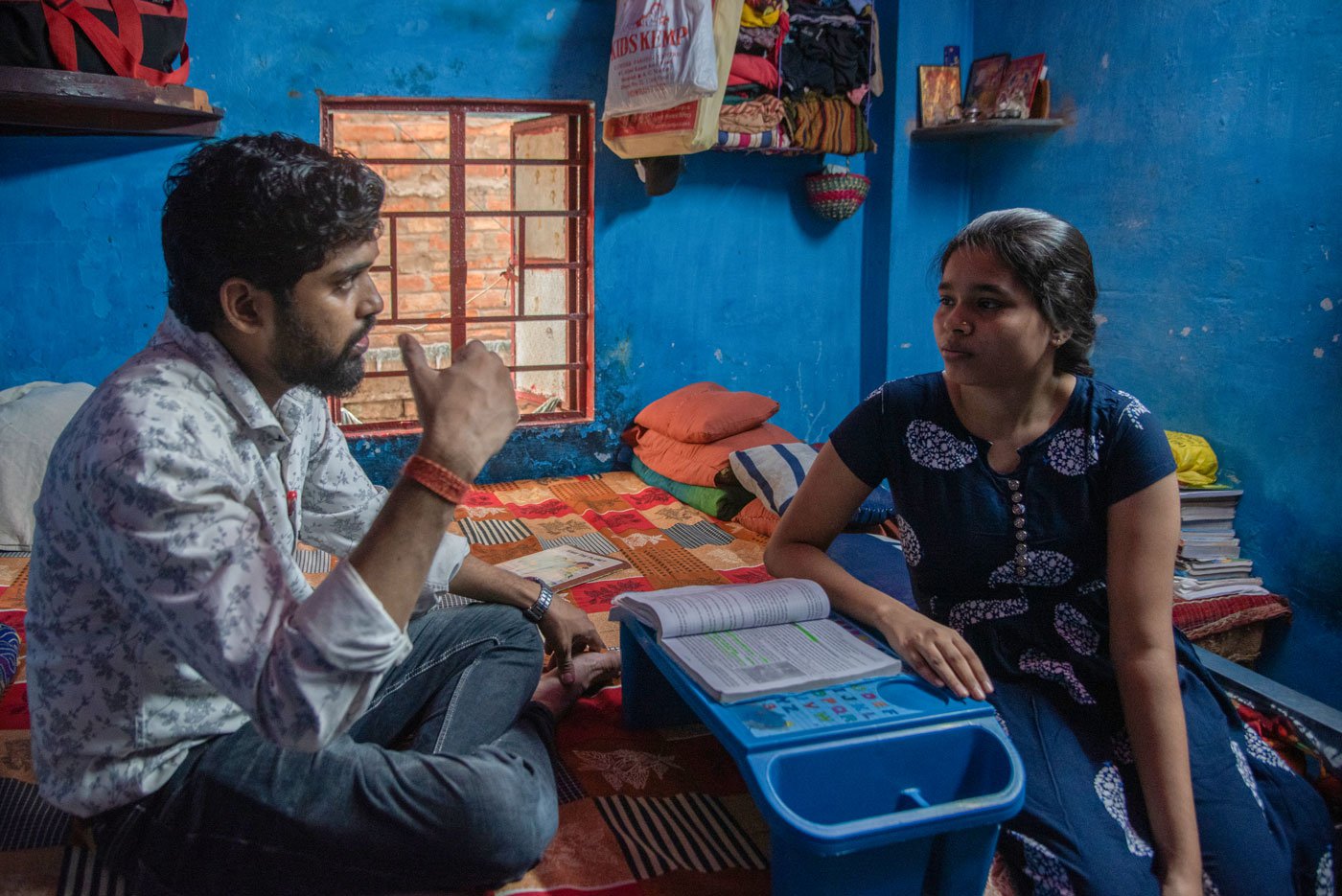

Rakhi Sharma (left) battled tuberculosis three times but is determined to return to complete her studies. A mother fixes a leg guard for her son (right) who developed an ulcer on his leg because of bone TB
The number of children with TB in the country is 28 per cent of the global childhood TB burden, says a 2021 National Health Mission report on adolescents and TB.
When Avik was diagnosed with TB, he had to drop out of school as he could no longer walk there from his home, a short distance away. “I miss my school and friends. They have also progressed and are one class above me now. I miss sports too,” says the 16-year-old.
In India, an estimated 3.33 lakh children aged between 0–14 years become ill with TB each year; boys are more likely to get it. “It is difficult to diagnose TB in children…the symptoms among children are similar to other childhood illnesses…” says the NHM report. It goes on to say that higher doses of medication are needed for young TB patients.
Seventeen-year-old Rakhi Sharma is recovering after a long battle and she still cannot walk without support or sit for long hours. Her family have always lived in the Pilkhana slum. The disease cost her an academic year. Her father, Rakesh Sharma who works in a food court in Howrah, says, “we are trying to catch up by appointing a private tutor at home. We are trying to support her in the best possible way, but we have financial limitations.”
Rural areas have higher cases of TB; those living in homes where the cooking fuel is straw or grass, those not having a separate kitchen and living in close quarters are most likely to get it, says the recent NFHS 5.
There is a general consensus among healthcare workers that not only is tuberculosis caused by poverty and consequent food and income deprivation, the disease itself is capable of worsening the poverty of affected people.

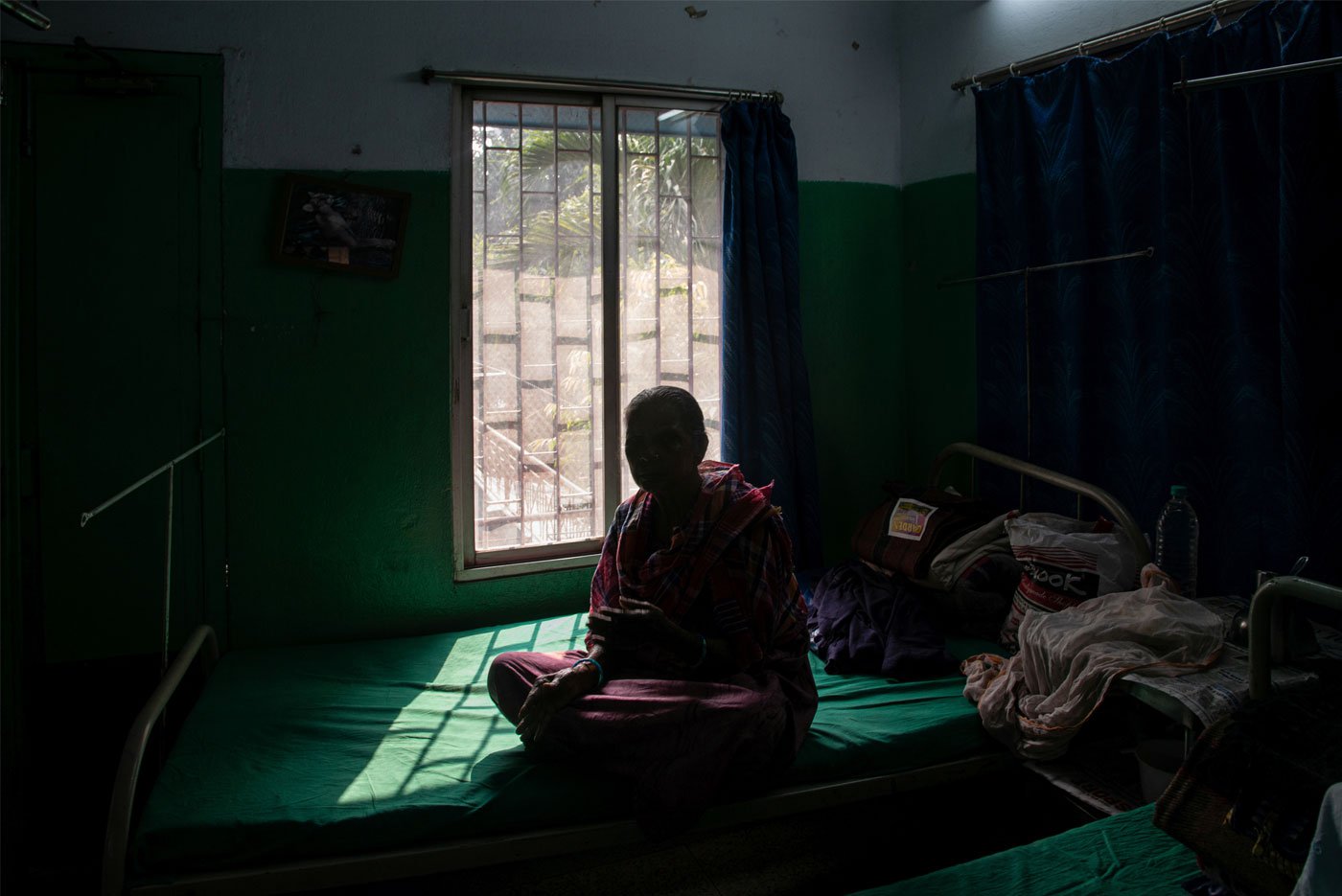
Congested living conditions increase the chance of spreading TB among other family members. Isolating is hard on women patients who, when left to convalesce on their own (right), feel abandoned


Left: Monika Naik, secretary of the Bantra St. Thomas Home Welfare Society is a relentless crusader for patients with TB. Right: Patients gather at the Bantra Society's charitable tuberculosis hospital in Howrah, near Kolkata
The NFHS-5 also notes that families with a TB patient are likely to keep it under wraps for fear of stigma: “...one in five men would want the TB status of a family member to remain a secret.” Getting healthcare workers for a TB hospital is also difficult.
A quarter of TB patients in India are women of reproductive age (15 to 49 years), says a National Health Mission report (2019). Although fewer women get TB than men, those who contract it are likely to privilege familial ties over their health.
“I want to go back [home] as soon as possible.I am afraid my husband will marry someone else,” says Haneefa Ali, is a TB patient from Bihar, who is worried about her marriage. She is most likely to stop taking her medications, says doctors at the Bantra St Thomas Home Welfare Society in Howrah.
“Women are the silent victims. They hide the symptoms and keep working. And later, when they are diagnosed with the disease, it's too late. The damage is done,” says Monika Naik, secretary of the Society. She has been working in the field of TB for more than 20 years and says that recovering from TB is a long process and takes its toll on the whole family.
“There are several cases where even if the patient has recovered, the families do not want them back. We really have to convince the family members,” she adds. Naik has received the prestigious German Cross of the Order of Merit for her tireless work in the field of TB prevention.
Alapi Mandal, who is around 40, has recovered from TB and says, “I am counting the days to go back to my family. They left me alone during this long battle…”
*****


Left: Prolonged use of TB drugs has multiple side effects such as chronic depression. Right: Dr. Tobias Vogt checking a patient


Left: Rifampin is the most impactful first-line drug. When germs are resistant to Rifampicin, it profoundly affects the treatment. Right: I t is very difficult to find staff for a TB hospital as applicants often refuse to work here
For healthcare workers, the risk of contraction is high and a mask is mandatory. At the clinic run by the Society, patients with highly infectious TB are kept in a special ward. The out-patient department serves 100-200 patients per day twice a week and 60 per cent are female patients.
Doctors working in the field point out that many patients develop clinical depression as a side effect because of prolonged use of drugs related to TB. Proper treatment is a long and complex process – after discharge, patients must take medicines regularly and they need a healthy diet.
Since most patients are from lower-income groups, they often stop medications mid-way which puts them at risk to develop MDR TB (Multi-Drug Resistance Tuberculosis), says Dr. Tobias Vogt. A doctor from Germany, he has been working on TB in Howrah for the last two decades.
Multidrug-resistant TB (MDR-TB) remains a public health crisis and a health security threat. Only about two in five people with drug resistant TB accessed treatment in 2022. The WHO’s Global TB repo rt says that, “In 2020, 1.5 million people died from TB, including 214,000 people with HIV.”
Vogt further adds: “Tuberculosis can damage any part of the body, including the bones, spine, stomach, and even the brain. There are children who contract tuberculosis and recover, but their education is disrupted.”
Many TB patients have lost their livelihoods.
“After I was diagnosed with pulmonary TB, I can't work anymore even though I
have recovered fully. My strength is gone,” says former rickshaw puller, Sheikh
Sahabuddin. A strong man who once ferried passengers in Howrah district, he is
helpless now. “I have a family of five. How to survive?” asks the resident of
Sahapur.


Left: Doctors suspect that this girl who developed lumps around her throat and shoulders is a case of multi-drug resistant TB caused by her stopping treatment mid way. Right: 'I don't have the strength to stand. I used to work in the construction field. I came here to check my chest. Recently I have started coughing up pink phlegm,' says Panchu Gopal Mandal


Left: NI-KSHAY-(Ni=end,
Kshay=TB) is the web-enabled patient management system for TB control under the
National Tuberculosis Elimination Programme (NTEP). It's single-window platform helps digitise TB treatment workflows and anyone can check the details of a patient against
their allotted ID. Right: A dress sample made by a 16-year-old bone TB patient at Bantra Society. Here patients are trained in needlework and
embroidery to help them become self-sufficient
Panchu Gopal Mandal is an elderly patient who comes for treatment to the Bantra Home Welfare Society clinic. He was a construction worker and now, “I don't have Rs. 200 with me and I don't have the strength to stand. I came here to check my chest. Recently I have started coughing up pink phlegm,” says the 70-year-old resident of Howrah. He says all his sons have moved out of the state for work.
The web-enabled patient management system for TB control – NI-KSHAY – aims to provide a comprehensive, single-window to see how treatment is working. Keeping track of TB patients and making sure their recovery is on track, is a critical component of care. “We feed all the patient’s details in it [NIKSHAY] and can keep track,” says Sumanta Chatterjee, administrative head of the Society. He also adds that Pilkhana slums have a high number of TB-infected patients because it is “one of the most congested slums in the state.”
Worldwide, TB is the second leading infectious killer after Covid-19, says the WHO, despite the fact that it is curable and preventable.
Further, the Covid-19 pandemic exacerbated the social stigma of coughing and appearing unwell, which potentially drove TB patients to conceal their illness from others until the severity of the disease and infectiousness worsened.
I regularly cover health issues, but I had no idea that so many people are still suffering from tuberculosis. Since it's not a fatal disease, it is not that widely reported. I saw that although it may not always be fatal. it can immobilise a family by affecting the primary breadwinner. Further, recovery is a protracted procedure, financially burdening families who already live at the margins.
Some names have been changed in this story.
The reporter would like to thank the members of Jayaprakash Institute of Social Change (JPISC) for their help with this story. JPISC works closely with children diagnosed with TB, trying to ensure their continued access to education.
